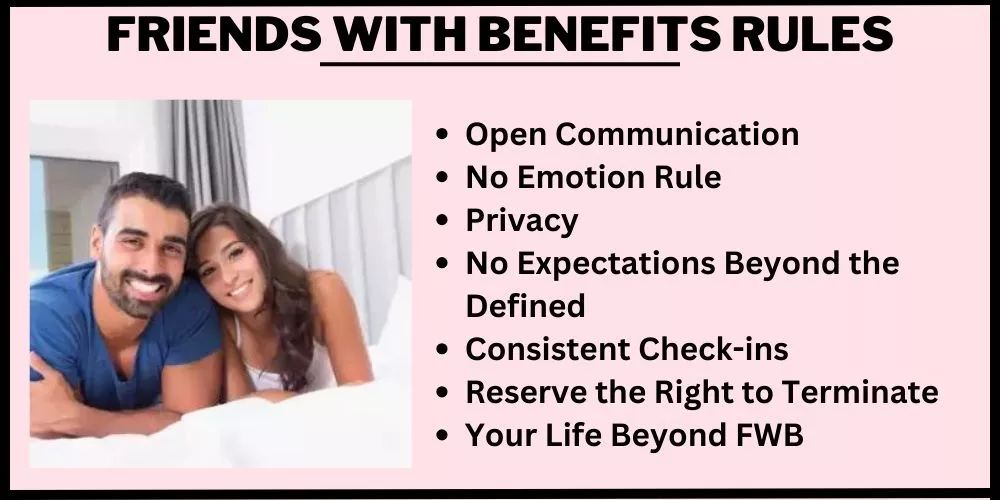In today’s modern world, as approaches to relationships evolve, navigating the potentially confusing territory between casual and committed can be challenging.
Enter the situationship vs fwb ( friends with benefits) debate, two non-traditional romantic arrangements that blur the lines between friendship and romance.
In this article, we’ll break down the key differences between these increasingly popular dynamics and offer valuable insights into making either arrangement work for you.

Join us as we delve into the rules, the expectations, and everything in-between.
Situationship Vs FWB (Friends with Benefits): A Detailed Comparison
The lines of relationships have blurred significantly in recent years. This has led to terms such as “situationships” and “friends with benefits” (FWB) gaining popularity.
Both indicate non-traditional forms of romantic bonds, but with distinct subtleties that define and separate them. Below, we expose these subtleties in a detailed comparison based on different aspects.
Definition
Situationship
- This refers to an undefined romantic relationship. It’s more than casual dating but less than a committed relationship. Participants enjoy each other’s company, share intimate moments, and potentially include romantic feelings, but labels and direct communication about the future are either limited or non-existent.
Friends with Benefits
- In a FWB arrangement, two individuals engage in physical intimacy while maintaining their primary relationship as friends. It typically lacks the romantic aspect, and the commitments or expectations standard in a typical relationship are usually absent.
Emotional Involvement
Situationship
- Emotions can be more complicated in situationships since boundaries are often undefined. It can involve deep emotional connection, but due to the lack of clear relationship definitions, these feelings might cause more confusion and uncertainty.
Friends with Benefits
- The primary rule of FWB is usually to avoid emotional attachments and focus solely on physical connection. It’s a more straightforward emotional setup, but problems can arise if romantic feelings develop, breaking the primary rule.
Decision Making
Situationship
- Decisions like spending the weekend together or meeting friends are often unplanned and spontaneous. Conversations about future planning are usually vague or avoided.
Friends with Benefits
- Boundaries are clearer than in situationships. Decisions about interaction outside the sexual sphere are often established upfront.
Communication Expectations
Situationship
- In this scenario, participants might share deep conversations, and their relationship can have the qualities of an emotional bond. Even if the discussions about defining the relationship or future together are fuzzy or avoided, the communication often resembles that of a serious relationship.
Friends with Benefits
- In a FWB arrangement, communication is often limited to logistics regarding their physical encounters. Exchanges of deep personal feelings or conversations resembling ‘pillow talk’ are often kept to a minimum to maintain the primary rule of no strings attached.
Public Perception
Situationship
- In situationships, the pair might present themselves as a couple in social situations, whereas the lack of formal commitment can generate a sense of confusion and ambiguity about their relationship status.
Friends with Benefits
- In a friends-with-benefits scenario, both parties usually agree to keep their physical relationship hidden from their social circles to avoid complications and maintain their original status as friends.
In both situationships and FWB, communication is paramount to prevent hurt feelings and misunderstandings.
While both arrangements are more casual than traditional romantic relationships, they each demand a unique understanding and management of expectations.
Understanding these differences can help individuals navigate their connections more effectively.
What is More Than Friends with Benefits but Less than a Relationship?
In the realm of romantic dynamics, the scenario where one finds themselves more involved than a typical friends-with-benefits situation, but not yet in a standard monogamous relationship, is often referred to as a ‘situationship’.

Here, individuals share more than just the physical intimacy of a FWB arrangement, but possibly deep emotional connections, spending considerable time together, and perhaps exhibiting elements of exclusivity.
However, they’d stop short of the labels, obligations, and long-term commitments that characterize a traditional romantic relationship.
What are the Blurred Lines in a Situationship?
Situationships inherently have a multitude of blurred lines due to the absence of defined parameters. Key areas of ambiguity include:
- Emotional Attachment: Individuals in a situationship often find themselves emotionally connected, but since they avoid the discussion of defining their relationship, it creates ambiguity about the extent of emotional involvement.
- Commitment Level: The level of commitment in a situationship is another blurred line. Without labeling the relationship, it stays unclear whether partners should remain exclusive or can see other people.
- Future Expectations: Conversations about future plans together are typically avoided in situationships. Consequently, it’s uncertain whether the duo expects their relationship to progress or remain as it is.
- Relationship Definition: The lack of a clear definition leads to a constant wondering about ‘what are we?’ This can cause emotional distress and confusion for both partners.
How Do You Tell If It’s More Than Friends With Benefits?
Telling if your relationship is more than just friends with benefits can be discerned from certain signs. These might include:
- Consistent Non-Sexual Meetings: If you’re hanging out together often in non-sexual contexts or settings, it could signify you’re more than just FWBs. This could involve attending social events together, spending casual time on weekends, etc.
- Deep Emotional Connection: Sharing personal feelings, discussing deep subjects, comforting each other during tough times might indicate your relationship has evolved beyond a FWB arrangement.
- Jealousy and Exclusivity: Feelings of jealousy when your partner sees other people or a mutual understanding of exclusivity also hint towards a relationship evolving beyond just being FWBs.
- Future Plans: Making future plans together or discussions about shared goals are not typical of FWB situations. If these are happening frequently, there’s a good chance your relationship is more than just FWBs.
Remember, if you find yourself in this scenario, open communication is key to clarify what you both want from this relationship and to minimize misunderstanding and hurt feelings.
Friends with benefits rules
Engaging in a friends with benefits (FWB) relationship can indeed be a complex and tricky situation, but establishing some rules from the outset can help handle expectations and prevent emotional turmoil. Here are some commonly advised rules for a successful FWB relationship:

1. Open Communication
For your FWB relationship to thrive, both parties must maintain open and honest communication. It’s crucial to discuss your intentions, set certain boundaries, and express your fears or concerns.
Remember, clear communication can preemptively address potential misunderstandings or confusion.
2. No Emotion Rule
The cardinal rule of a FWB relationship is to keep emotions separate from this arrangement. FWBs involves physical intimacy without the emotional baggage that often accompanies a romantic relationship.
This means you have to be vigilant about developing romantic feelings for your partner, as it can complicate things.
3. Privacy
To keep things less complicated, it’s often best to keep your FWB situation private. This helps prevent outside opinions from influencing your relationship and avoids any awkward social situations.
4. No Expectations Beyond the Defined
Unlike traditional relationships, FWB relationships don’t typically contain the expectations of companionship, emotional support, or exclusivity.
It’s pivotal to remember your roles and maintain the line between friends and romantic partners.
5. Consistent Check-ins
Regular check-ins are essential to ensure you both are still on the same page emotionally and understand where your relationship stands.
If one participant starts developing feelings, it’s crucial to reconsider the arrangement or the rules.
6. Reserve the Right to Terminate
Define rules for ending the relationship. Either person should have the right to end the physical aspect of the relationship at any point, with no hard feelings. It’s crucial to respect this choice if it happens.
7. Your Life Beyond FWB
Even though you’re enjoying your FWB relationships, don’t let it interfere with your daily life.
This means continuing to meet other people, hanging out with friends, and not giving up on finding a solid, committed relationship if that is something you desire.
These rules should serve as guidelines, helping to clarify and set the course of an FWB relationship. Remember to always consider each other’s feelings and be respectful towards each other to make this arrangement successful.
frequently asked questions (FAQs)
How Many Months is a Situationship?

There is no specified timeline for a situationship as it depends on the individuals involved and their personal circumstances. However, it typically can range from a few weeks to months or even years. Unlike a traditional relationship, a situationship does not progress through defined stages; thus, its duration can be quite variable.
How Often Do You See Each Other in a Situationship?
The frequency of meetings in a situationship varies significantly; there are no set rules. Some people in a situationship might see each other daily, while others might meet once a week or even less frequently. It largely depends on the convenience, desires, and the mutual agreement of both parties involved.
What is the Talking Stage of a Situationship?
The talking stage of a situationship is the phase where individuals communicate frequently and get to know each other on a deeper level but without any distinct commitment or labeled relationship. This stage often involves sharing personal feelings, experiences, and potentially developing an emotional connection. There is usually no official ‘next step’, contributing to the situational nature of this relationship.
What are Red Flags with Friends with Benefits?

Red flags in a friends-with-benefits (FWB) scenario may include developing romantic feelings for each other, intense feelings of jealousy when the other person dates someone, the intrusion of the FWB arrangement into your daily routine, or being secretive and awkward around mutual friends. Another flag is neglecting to maintain clear communication about desires or concerns, which could lead to emotional pain or misunderstanding. These signs might indicate that the current arrangement could be veering off-course and necessitating reevaluation.
Conclusion :
‘Situationships’ and ‘Friends with Benefits’ are two distinct types of relationships, each with their own complexities and unique circumstances.
Situationships often involve deeper emotional connections and more involvement beyond physical intimacy, while FWBs focus mainly on the physical aspect.
Recognizing the differences, maintaining effective communication, and setting clear boundaries can help individuals navigate these unconventional relationships.
In any case, it’s important to engage in relationships that respect your emotional wellbeing and meet your desired level of commitment.
